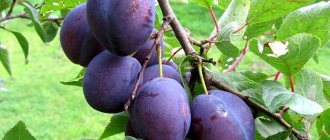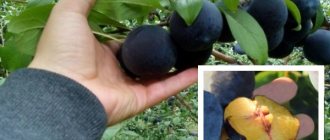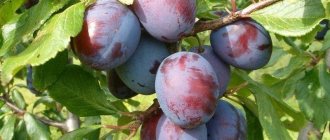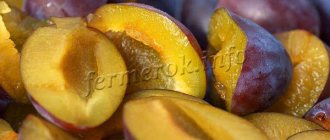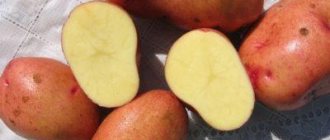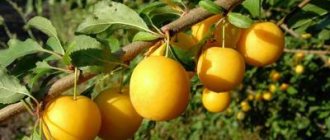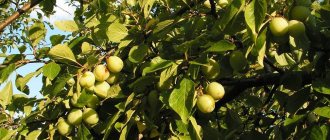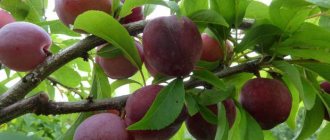Stanley plum - variety description, photos, reviews, frost resistance
Plums are often grown in garden plots, but it is not always easy to choose the right variety from the many varieties of these fruit trees. The main requirements for plums are high yield, large fruit size and resistance to cold.
This article will talk about a fairly old variety of these fruit trees, but still popular among gardeners in many countries around the world - the Stanley plum.
The content of the article:
1. History of the variety 2. Description and characteristics of the variety 3. Productivity of the Stanley plum variety 4. Pollinator trees for the Stanley plum 5. Diseases and pests 6. Pros and cons of the Stanley variety 7. Stanley variety: planting and growing 8. Further care of the plum Stanley 9. Feeding plum fruit trees Stanley 10. Pruning plum trees Stanley 11. Reviews of Stanley plum
Peculiarities
Stanley plum (variety description, photos and reviews from gardeners indicate the merits of the plant and berries) has the following advantages:
- high productivity;
- good resistance to negative winter weather conditions;
- large berry sizes;
- ease of transportation;
- resistance to a disease such as polystigmosis.
However, this variety also has some negative properties that many gardeners complain about:
- not very good drought resistance. The tree needs frequent watering in the absence of rain for a long time;
- demands on soil. A tree can grow well and bear a bountiful harvest only when planted in fertile soil;
- low resistance to moniliosis;
- The plant does not resist plum aphids well.
The Stanley variety could be an ordinary, unremarkable plum if the berries were not large and if the tree were not so unpretentious in care. But thanks to its positive qualities, this plum variety has earned the attention of gardeners.
According to the characteristics, photographs and reviews of gardeners, its cultivation does not require much effort, and the work that will be invested in caring for the fruit tree will definitely pay off.
History of the variety
This plum was bred by the American breeder Richard Wellington, who worked at an agricultural station in New York in 1912. This specialist took as a basis the French plum variety Dagen and the American variety Grand Duke.
The result was a new variety of Hungarian. This variety is also called “Stanley”.
Photo of Stanley plum
In Russia, this variety appeared more than half a century after its cultivation, and was included in the State Register only in 1983 and zoned for cultivation in the North Caucasus region and in the southern regions of the country.
Stanley plum - description and characteristics of the variety
Stanley plum is a late-ripening variety.
The buds on this fruit tree appear in the second ten days of April, and the harvest can be harvested from the last ten days of August to the first ten days of September.
The height of the Stanley plum is about 3 m. The crown is round, slightly elongated, but quite sparse. The main trunk is located vertically, its color is dark gray, the peeling of the bark is medium. The lateral branches are purple with a crimson tint, without pubescence, but with a sufficient number of spines.
A quick overview of the Stanley plum - video
Vegetative buds are 0.2-0.2 cm in length, their shape is cone-shaped with sharp tips.
The leaves of the Stanley variety are slightly elongated, 7.5 cm long and 5.5 cm wide, round in shape, with blunt-pointed ends, a rounded base, and teeth along the edges. The foliage blades are glossy, medium-concave with a loose consistency, bright emerald color. The upper side of the leaf is smooth, the lower side is slightly pubescent. The petioles are anthocyanin in color, up to 2 cm long. Two leaves can grow from one bud.
Flowers appear on last year's branches or on bouquet shoots.
Their diameter is about 3 cm, the color of the petals is white. Pedicels are without pubescence, reaching a length of 1.5-2 cm. The weight of one Stanley soybean fruit is 35-45 g, one side is more convex than the other.
The berries are obovate in shape, at the base they are more elongated, the top of the fruit is rounded. The skin is smooth, of medium thickness with a slight waxy coating, dark purple in color. Brown dots are clearly visible under the skin. The stone is oval-elongated, easily separated from the pulp of the ripe fruit.
The taste of Stanley plums is quite good, tasting score is 4.7 points out of 5. Ripe plums are sweet with a slight sourness. The pulp is fibrous, compacted, yellow in color.
The presentation is good, the fruits ripen at the same time, their sizes are approximately the same. The harvested crop tolerates transportation well over long distances.
Ripe fruits are of universal use; they can be eaten fresh; the process of drying plums produces excellent prunes.
Plums are also used in preservation - they prepare compotes, marmalades, jams, and use them for juice.
Important!
The Stanley plum variety is highly resistant to frost and can withstand cold snaps down to -32-34 degrees below zero.
Harvest and storage
Plum blossoms begin in April, but Stanley is a late-ripening variety. Fruiting occurs at the end of August - beginning of September. The variety is high-yielding; about 60–70 kg of plums are harvested from one tree.
Stanley begins to bear fruit 4–5 years after planting
Plums do not lose their taste and attractive appearance when stored in the refrigerator for 5–6 days. The fruits tolerate transportation well.
For freezing, plums are washed, dried and packaged in 1 kg plastic bags. It should be taken into account that when stored frozen for a long time, the taste of plums becomes sour.
In addition to fresh consumption, plums are used to make preserves, jams, marmalade, juices and homemade wines, and prunes.
Stanley plum is very popular and there is a lot of additional information on the dacha.help website.
Pros and cons of the Stanley variety
The main advantages of the Stanley variety include:
- high immunity of the plum, thanks to which it practically does not suffer from all known diseases, even without preventive spraying of the crown;
- the variety tolerates winters well in the middle zone and Siberian regions due to its high resistance to frost;
- The Stanley variety is self-fertile, so the yield is stable and high. But if there are other pollinating trees nearby, higher yields can be harvested;
- Thanks to the dense skin, the fruits are not prone to cracking even during the rainy season and after full ripening.
There are few disadvantages to the Stanley plum. It should be noted that this variety can be susceptible to rot, and also requires cultivation on soil of high fertility.
Diseases and pests
The Stanley plum variety is resistant to polystigmosis and plum pox (sharke), but is often attacked by plum aphids and can be affected by fruit rot (moniliosis). Careful care and timely preventive measures will protect fruit trees from diseases and harmful insects, and will also increase immunity to other ailments.
Fighting plum diseases - table
| Disease | Nature of the lesion | Processing period | Prevention measures | Fighting methods |
| Clusterosporiasis (hole spotting) | It affects branches, leaves, buds and flowers of plum trees. It appears in the form of actively growing brown-brown spots with a red border, from which gum subsequently flows. Leads to drying and falling of leaves and flowers, to a decrease in yield. | After flowering - twice with a break of 14 days. | Spraying trees with a solution of 1% Bordeaux mixture (100 g per 10 l of water) or copper oxychloride (40 g per 10 l of water). |
|
| Moniliosis (fruit rot) | It affects fruits, forming rapidly growing brown spots on them. Leads to rotting and dropping of fruits. |
| Spraying with 1% Bordeaux mixture. |
When collecting diseased fruits, do not touch healthy ones, as this leads to the spread of the disease. |
| After the harvest. | Treatment with copper sulfate (100 g per 10 liters of water). Use no more than 3 liters of solution per tree. | |||
| Polystigmosis (red spotting) | Affects the foliage of trees. It appears in the form of red spots that actively grow and turn into convex pads with spores. Leads to premature drying and falling of leaves, reduced yield and resistance to frost. | At the first signs of detection of the disease. |
| Spraying with a 3% solution of Bordeaux mixture in the green cone phase and with a 1% solution immediately after flowering. |
| Sharqa (smallpox) | Damages leaves in early spring, spreading in the form of light spots. Later, the disease is transferred to the fruits, which leads to their spoilage and premature falling. | At the first signs of the disease. |
| It is impossible to get rid of smallpox, so affected trees must be cut down and then burned. |
Plum diseases in the photo
With the development of polystigmosis, the spots on the leaves thicken and become bright red and shiny.
As pox develops, the leaf becomes marbled, with distinct light and dark green areas.
Moniliosis develops especially strongly in damp weather in spring and the first half of summer.
In case of severe damage by clasterosporia, the shoots die off even before the buds open.
Pest control - table
| Pest | Description and nature of the lesion | Processing period | Fighting methods | Prevention measures |
| Plum aphid | Small pale green insects that damage shoots, causing leaves to curl and dry out. | Before and after bud break. |
| Treatment with Nitrafen before bud break and Karbofos after bud break. |
| Weevil | Beetles damage plum buds, flowers and fruits. Female weevils gnaw holes in the bones and lay eggs. Beetle larvae feed on the kernels. Weevil infestation leads to fruit drop and reduced yield. | After flowering - twice with an interval of 10 days. | Spraying trees with chlorophos solution (20–30 g per 10 liters of water). | Treatment of tree trunk circles in the fall: thorough digging, removal of weeds and mulching of the soil. |
| Plum moth | Small butterflies of gray-brown color. Pupae are pale brown, up to 8 mm. The caterpillars are red, with a dark head. They damage fruits and feed on their pulp, which leads to premature withering and shedding of fruits. | At the first sign of caterpillars. | Spraying with Karbofos (90 g per 10 l of water) or benzophosphate (60 g per 10 l of water). |
|
| Shoot moth | A small butterfly up to 12 mm in wingspan. Caterpillars of shoot moths damage buds and buds by feeding on their juices. | Before and after bud break. | Spraying with DNOC (1 sachet per 10 liters of water) or chlorophos (30 g per 10 liters of water). |
|
Harmful insects in the photo
In the middle zone, aphids produce offspring up to 12 times
Buds damaged by shoot moths die
Fruits affected by the plum moth are less colored and ripen earlier
In spring, weevils awaken one after another, gradually
Stanley plums: planting and growing
Stanley plum seedlings should be planted in a permanent place in early spring.
, before sap begins to flow and buds open. When planting in the fall, it is difficult to choose the moment so that the young tree has time to take root before the onset of frost, which is why this plum often freezes out by spring.
It is important to know!
Planting pits are prepared in the autumn. Their size depends on the volume of the seedling's root system. In fertile soil, the dimensions of the hole should be 0.6 * 0.8 m, in poor soil - 1.0 * 1.0 m, in order to add organic matter and mineral fertilizers when planting.
The site should be sunny, protected from gusts of cold wind, without stagnant moisture in the soil. The groundwater level should not be closer to the ground surface than 2-2.5 m.
Plums are planted next to other fruit trees, preferably stone fruits.
But you can plant it next to apple or pear trees, the main thing is that these trees do not shade it.
Photo of plum planting
Important!
A stake is driven into the middle of the planting hole, to which the seedling is tied. Before installing the tree, pour a bucket and a half of water into each hole, wait until it is absorbed, and only then install the tree. Straighten its roots along the diameter of the hole, tie the tree to a stake so that its height is lower than the first branches of the seedling.
Then the hole is filled with earth, compacting it evenly. A roller of earth is made along the diameter of the tree trunk circle so that when watering the water does not go beyond its boundaries.
Step-by-step instructions for landing
It is easier to plant seedlings with two people - an assistant will hold them in an upright position while filling the hole. Planting a Stanley plum seedling:
- The substrate in the pit is moistened. When moisture saturates the substrate, place a support - it should be 30-40 cm longer than the seedling.
- The seedling, prepared for planting, is placed on the top of the formed mound and the roots are straightened. The hole is filled with soil, filling the inter-root voids - for this purpose the earth is compacted from time to time.
- When the hole is filled, control the position of the root collar - it should be 5-7 cm above the ground surface.
- The tree is watered with three buckets of water. Moreover, they pour it not at the root, but into ring-shaped grooves dug at some distance from the trunk. When the water is absorbed, the tree trunk circle is sprinkled with peat, straw or grass.
- The tree is tied to a peg. All shoots on it are shortened by a third.
Further care
Stanley plum care is fairly standard. If the season is dry, then this fruit tree should be watered once every 20-26 days. During the rainy season, the amount of watering is reduced. You should also regularly loosen the tree trunk circle and add a layer of mulch, which will protect the soil from rapid evaporation of moisture. It is also necessary to remove all weeds regularly.
FRUIT TREES!
• Pear Chizhovskaya • Apple tree Lungwort • Apple tree Ligol
Wintering and protection from rodents
Stanley plum tolerates cold well, but it is recommended to insulate young trees. In addition, for trees of any age, whitewashing of the trunk is recommended - it is covered with a solution of slaked lime mixed with copper sulfate and office glue.
The barrel, protecting from the cold, is wrapped in any breathable material - you can use regular burlap or nylon tights. Black material is not suitable - the wood may get sunburned. To better protect the trunk from rodents, it is fenced with a metal mesh.
Insulation options:
- Wrapping. The trunk is wrapped with burlap or other material several times. Spruce branches are placed between the layers, and the resulting structure is securely fixed.
- Covering with a box. If the tree is small, you can cover it with a cardboard box, filling the empty space with sawdust, pine needles, and newspapers.
- "Hut." They make a frame from willow twigs stuck into the ground. Hay, leaves, and straw are thrown on top. Then the “hut” is covered with roofing felt.
To insulate the roots, the layer near the trunk is mulched, creating a layer of 6-7 cm. A mound 20 cm high is placed near the trunk.
Feeding Stanley plum fruit trees
In the first two seasons, you need to take care of special fertilizing for the growing Stanley plum - once every 3 months, a heteroauxin solution is applied to these trees. This fertilizer is prepared for each tree as follows: 2 tablets of the drug are diluted in 10 liters of water, immediately after preparation the fertilizer is applied to the tree trunk.
How to properly fertilize plums - video
In the second season, rotted manure is introduced into the tree trunk circle at the rate of 5 kg per square area.
This variety is very sensitive to the lack of basic elements in the soil - with a small amount of nitrogen, the foliage begins to chlorosis and the tree is sprayed with a solution containing urea.
With a lack of potassium, the foliage on the shoots turns brown. If there is not enough magnesium, the veins on the leaf blades of fruit trees turn brown. The Kalimag fertilizer effectively helps combat the deficiency of these minerals (up to 45 g of the drug is applied per square).
It is important to know!
If the vegetative mass is growing weakly, and the tree itself is depressed, nitrogen fertilizers should be applied in early spring (20 g for each square of the tree trunk area).
Before flowering begins, organic matter is added to the soil.
To do this, 5 kg of mullein or bird droppings are diluted in 4.5 buckets of water. For each plum, apply from 40 to 60 liters of this fertilizer. Organics can be replaced with mineral fertilizer: 1 tbsp. l. saltpeter is diluted in a bucket of water.
For each young fruit tree, 20-30 liters of this solution are applied, for older plums - 40-60 liters. After applying fertilizer, the tree trunk circle is mulched with peat or sawdust.
In the summer, a solution of manure is introduced into the tree trunk circles, which is diluted in a ratio of 1:10 or chicken manure, diluted in a ratio of 1:20. Such fertilizing is applied to circular trenches, which are made on the border of tree trunk circles.
How to care for a tree
On the one hand, special care is not required to grow Stanley. But it is important to monitor pruning, watering, loosening and fertilizing. The plum tree suffers the most from lack of moisture, so frequent additional irrigation is required.
Care after landing
Plum trees need seasonal care: watering, loosening, pruning.
In the summer months, the tree is fed and watered. In the fall, they carry out sanitary pruning, insulate them before wintering, and apply the necessary fertilizers. In winter, it is necessary to check how well the insulation works, shake off snow from the branches and prevent icing.
In the spring, the trunk is whitened, dry and damaged branches are trimmed, and the plants are fed. During this period, preventive measures to combat pests are carried out.
Irrigation scheme
Stanley loves water and needs regular watering. But moisture should not be allowed to stagnate. Therefore, water the tree once a week in normal weather, 10-15 liters per tree. In extreme heat and lack of rain, increase the irrigation regime to 2 times a week.
Water either in the morning or in the evening, when the sun is not shining too brightly. During the fruiting period, irrigation is carried out 4-5 times more often. The main thing is not to let the wood dry out.
Plum fertilizer
Start adding nutrients from the second year of growth. In the first year, what was laid down during planting is enough.
The feeding scheme is as follows:
- In the spring, when digging, add rotted compost or humus. 10 kg per m2 is enough. Add to it 100 g of superphosphate, potassium sulfate, 50 g of urea, 0.4 kg of wood ash. We recommend the article - How to use ash in your garden.
- Every three years, feed the plums with the same mixture before wintering in the fall. But take exactly half of the specified amount.
- In the fifth year of growth, increase the proportions of fertilizers by half, except for phosphorus and nitrogen, as they contribute to the formation of the green part.
- Be sure to mulch the tree trunk after watering and fertilizing - this will help retain moisture for longer. Use compost, peat, manure, straw or pine needles. Learn even more about mulching garden plants.
- Apply 40 g of urea and potassium sulfate at the end of spring.
- At the beginning of summer, feed the plants with urea and nitrophoska, 35 g each.
- At the end of the season, feed with potassium salt and superphosphate, 30 g per tree.
Nuances of pruning
Prune like any fruit tree in spring and autumn, removing dry, diseased and damaged branches.
Prune in March before buds open and in November after the tree goes dormant. Trim off any frozen or broken shoots. Afterwards, be sure to treat with garden varnish or a weak solution of potassium permanganate. All tools must be well sharpened and disinfected.
Crown formation
Start the formative procedure from the first year. Remove up to ⅓ of the length of shoots from a young seedling.
In subsequent years, prune improperly growing branches: inside the crown, down and up, as well as weak and thin shoots. After the tree reaches 2.5-3 meters, pinch the main shoot to prevent the plum from growing higher and forming side shoots. If you do not take care of the tree, it can grow more than 5 m.
Pruning Stanley Plum Trees
This variety should be pruned annually, as the Stanley plum grows too many shoots during the season, which will grow inside the crown, thickening it, and also in different directions, creating an irregular shape of the tree.
Formation of a plum crown - photo
Excess shoots should be cut out while removing dried, broken, damaged and old tree branches. Once every 5-6 seasons, sanitary pruning is carried out.


